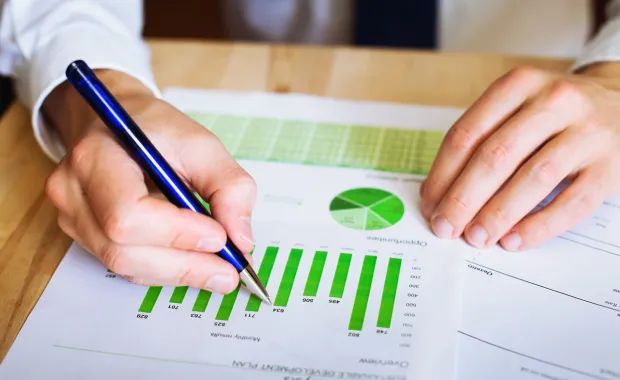- Chapter 1: Introductions
-
Peter Warren:
Welcome to another session of our ongoing series of podcasts as we discuss components of the energy supply chain. Hello, Nicole, Hello, Richard. How are you guys?
I'm Peter Warren, based in Toronto, and the global energy lead for oil and gas and utilities.
Nicole, why don't you describe who you are and why we’re going to talk about sustainability and the meaning of that for this industry?
Nicole Zethelius:
I am Nicole Zethelius, Head of Sustainability and ESG Strategy for CGI in Scandinavia, and a global subject matter expert around sustainability. I have been a Senior Advisor for the United Nations Economic Commission for Europe on Scope 3 (of the Greenhouse Gas Protocol corporate standard), and advisor to IPCC (Intergovernmental Panel on Climate Change), with knowledge around sustainability and all of the factors that are related to it.
Peter Warren:
All those factors. We'll get into some of those in a bit, including around data and other components.
And my friend Rich from the UK. How are you, sir?
Richard Hampshire:
Very good. Thank you, Peter. I’m Richard Hampshire based out of our UK and Australia operation, primarily working with our utilities clients on the energy transition, as we progress through that, and how it's going to affect their need for digital solutions and greater use of data. Historically, I’ve worked for one of our clients, particularly in energy retail, but by academic background, I'm a power engineer.
- Chapter 2: Trends in sustainability in energy and utilities
-
Peter Warren:
Very good. Thank you. As we are building these different podcasts, we obviously have a bit of a dress rehearsal. We went through this, and the question was how are we going to talk about utilities and sustainability and what's going on, as it's actually happening in real-time and moving along. In our prep session, we thought we'd have five minutes of material, and we talked for an hour. So, we'll try and be concise today.
What we sort of landed on is that energy and utility companies have been actually driving towards sustainability. In our Voice of Our Clients survey of last year, utilities were number one, and oil and gas was number three by industry, of having this as a concern as they want to drive their business. I would argue that, because they've been driving efficiency for years, doing things that took out cost, or reduced the number of trips something had to make, they've been actually driving towards sustainability. Sustainability's probably been core to them for a long time.
- Chapter 3: Importance of using data to prove sustainability
-
Peter Warren:
Nicole, how do you see that moving forward as we go into the more formal Scopes 1 (direct GHG emissions), 2 (electricity indirect GHG emissions) and 3 (other indirect GHG emissions) of sustainability?
Nicole Zethelius:
We're looking at the trends in terms of sustainability, and we look at hard to abate sectors. Energy happens to be one of those. What we need to be able to do is utilize data to prove just how sustainable that is—what it means to be sustainable, whether it's relevant in one region or another region. We do see that the definition and terminology around sustainability differs so greatly between cultural ideologies and geographical location.
We need to be able to provide a clear, common denominator of information to consumers and to businesses on what is the best practice and best solutions around energy. This is one of the main goals, in the end, looking at the density of usage and the transition to using electricity more abundantly than before. Utilities is an essential component to the puzzle and the complexity around sustainability.
We do need to have this measurable, quantifiable, qualitative and quantitative information around just what is the difference between green hydrogen and blue hydrogen. What is the difference between solar energy sources or wind power? Really, to look at the whole entire life cycle assessment so that the decisions that are made today are informed decisions, whether that's by a household or a business.
- Chapter 4: Assessing sustainability maturity
-
Peter Warren:
It's kind of cool. Your point about measurable is an interesting one. It’s that, not only do they need to change, but they need to know where they are today. They have to do a bit of an assessment of their situation today so that the mix of how they are doing, if they're doing a lot of things—let's say through energy production for electricity, through hydroelectric, some solar or some wind, maybe they still have some coal, maybe they still have some natural gas, or have to have it just to do some load balancing and nuclear. All of those things have different factors, would you agree, and different scores on greenness? I don't know how you would reference it in ESG.
Nicole Zethelius:
We look at it from a maturity perspective. If you are to actually do it the proper way, instead of just looking at it, whether green or not green, I think it's on a scale of just how mature and prepared that type of electricity or power is compatible with future fundamental shifts in society or in the environment, and how they can handle change. So, sustainability really deals with that preparedness, that readiness, and that maturity around it. Even if we look at, for instance, solar energy and wind energy, they are fairly new sources of energy. We need to keep that into consideration when we are buying into renewables, that this whole decision-making process needs to be really brought to light.
We need to use newer and different types of data to assess it and look at it from a much longer-term perspective, because we don't want to be in a situation where we are today, where it was a level of good intention to transition from burning wood, for instance, to using gasoline. And now, we are in a situation where we want to move away from gasoline, or move away from other sources that we use too much of, so that we can balance out the sheets of resource utilization. This is where it boils down to. What kind of information do we need to be able to measure that?
- Chapter 5: Greater visibility requires access to data
-
Peter Warren:
Thanks. And, Rich, what's your thought on that? You have a long history of working for utilities, working in the industry. You've seen the shift from data, I know you're a fan of open data, as well within the UK market. How do you see all of this moving forward? Not just for what we traditionally did with that data, but as we move into ESG.
Richard Hampshire:
I think data underpins a lot of the decisions that need to be taken. But, from a utilities perspective, why are utilities taking this so seriously? Particularly, Nicole highlighted electricity and hydrogen. I'm much taken with a statistic from 2020, that 73% of all greenhouse gas emissions come or arise from the consumption of energy, and that's from the World Resources Institute (WRI). If you break that out, 17.5% of those emissions are the energy used in buildings. 11.9% is road transport. So, if we look at that, approximately 30% of energy use in buildings and road transport combined, contributes to global greenhouse gas emissions. (See WRI website for the latest figures.)
So, if we start to think about what other sectors are doing to reduce emissions, to address climate change, they're looking to decarbonize largely through electrification or the replacement of natural gas or oil. If we think about that, there's great pressure on the electricity and gas sectors to decarbonize and to be at the vanguard of that. Now, if we start to think about how they're achieving that, then it is a shift away from conventional oil, coal, gas generation, even away from nuclear generation, although that's obviously low carbon, towards renewables, towards wind, towards solar.
It's also a change on the demand side as well, as we adopt more electric vehicles, as we potentially heat our homes using heat pumps and other electric means, as we start to adopt solar panels actually behind the meter in our homes and businesses. If we look at that from a strategic level, in terms of the way the electricity system particularly operates, then it's changing fundamentally the dynamics of that system.
If you're going to continue to operate that system, and for all of us to continue to benefit from and enjoy the levels of reliability that we get today, then much greater visibility of the system is going to be required. Where does that come from? It comes from access to data. It comes from a much more intelligent infrastructure, the ability to collect that data, to analyze that data, and make meaningful decisions.
Then, for us as consumers, as energy users, how many of us actually think about that? I think it's safe to say most of us will walk into a room, throw a light switch, and we just expect it to work. Indeed, the success of the sector is that we have that expectation. We've come to take it for granted.
So, do I see, us as individuals, being actively involved in taking those decisions? That's potentially quite hard. But I see an absolute role for technology, and digital technology, to help automate some of those processes in the same way that we've adopted smartphones into our lives over the last 15 years, or so. We now walk around with something in our pocket that basically tells us where we need to be, gives us access to the internet, helps us make decisions around how we move around, what trains we get on the morning, what time to get to the railway station. That sort of automation, that sort of intelligence, is increasingly going to become important in the energy system.
Peter Warren:
Well, thank you very much everybody. This concludes part 1 of our 2 parts on energy and sustainability. Thank you very much and we’ll see you in the second half.







